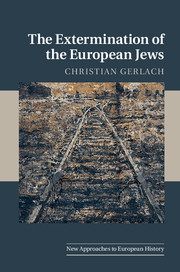Book contents
- Frontmatter
- Contents
- List of tables
- Acknowledgments
- List of abbreviations
- 1 Introduction
- Part I Persecution by Germans
- Part II Logics of persecution
- Part III The European dimension
- 12 Legislation against Jews in Europe: A comparison
- 13 Divided societies: Popular input to the persecution of Jews
- 14 Beyond legislation: Non-German policies of violence
- 15 In the labyrinths of persecution: Survival attempts
- 16 Conclusion: Group destruction in extremely violent societies
- Bibliography
- Index
13 - Divided societies: Popular input to the persecution of Jews
from Part III - The European dimension
Published online by Cambridge University Press: 05 March 2016
- Frontmatter
- Contents
- List of tables
- Acknowledgments
- List of abbreviations
- 1 Introduction
- Part I Persecution by Germans
- Part II Logics of persecution
- Part III The European dimension
- 12 Legislation against Jews in Europe: A comparison
- 13 Divided societies: Popular input to the persecution of Jews
- 14 Beyond legislation: Non-German policies of violence
- 15 In the labyrinths of persecution: Survival attempts
- 16 Conclusion: Group destruction in extremely violent societies
- Bibliography
- Index
Summary
There was a complex interrelationship between official policies and the activities of non-state actors, whether in Germany or elsewhere. Citizens were affected by government propaganda, but they also, in turn, tried to influence government policies in their own interest. A clear-cut distinction between official and private contributions is not usually possible; state functionaries and citizens cooperated in too many ways. What ordinary people did was influenced not only by the state but also by their social situations, the ideas and actions of enemies and allies from other countries, and deep-rooted attitudes (against Jews and toward diverse related political issues).
A very common question in this context – often the first – is how anti-Semitic the population of a particular country was. There are a number of reasons why this will not be central to this chapter. First, there is no convincing way of measuring anti-Jewish attitudes. With one notable exception (see below), we lack contemporary opinion surveys, let alone a series of them over time. Retrospective polls after World War II about anti-Jewish attitudes before 1945 cannot be trusted as the moral frameworks had changed radically. Second, answers to the question ‘How anti-Semitic was a country?’ are usually speculative, vague and overly sweeping – in part because their bases are national frameworks. Resembling outdated and unscientific inquiries about ‘national character,’ they ignore vast differences among groups (and individuals) within countries. In fact, one important insight is that a great deal of diversity existed. To be sure, it is not enough to state this fact, for ubiquitous contradictions do not account for the very different outcomes in terms of the persecution and survival of Jews. Yet, third, it may be somewhat comforting that popular attitudes toward Jews among the population of a country, though they did matter, were only one factor determining this outcome. Romania is supposed to have been a strongly anti-Semitic country, but survival rates for Jews were higher there than in Croatia, Slovakia and Hungary. Many scholars assess anti-Jewish attitudes in France as being stronger than in Norway, Greece or the Netherlands, and yet the survival rate was much higher in France. This may underline how questionable judgments about a national level of Jew hatred are, but it also indicates that attitudes did not necessarily lead to related action.
- Type
- Chapter
- Information
- The Extermination of the European Jews , pp. 336 - 367Publisher: Cambridge University PressPrint publication year: 2016



